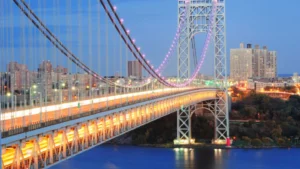1. Name Origin: George Washington Bridge
The bridge is named after George Washington, the first President of the United States. It is a tribute to the nation’s founding father and was dedicated to the ideals of American freedom and democracy.
2. Breathtaking Views:
The George Washington Bridge offers spectacular views of the Manhattan skyline, making it a popular spot for photographers and tourists.
3. Double-Decker Design:
The bridge is a double-decker suspension bridge, with a total of 14 lanes, eight on the upper deck and six on the lower deck, for vehicular traffic.

4. Pedestrian Walkway:
In addition to vehicular traffic, the bridge has a walkway on the south side of the upper level, which is open to pedestrians and cyclists. It provides another way to enjoy the stunning views.
5. Construction Era: George Washington Bridge
The George Washington Bridge was constructed during the Great Depression, providing much-needed employment and economic stimulus.
6. Art Deco Style:
The bridge’s towers and other design elements reflect the Art Deco architectural style, which was popular in the early 20th century.
7. Record Span:
When it was completed in 1931, the George Washington Bridge held the record for the longest main span in the world. The main span measures 3,500 feet.
8. The “Bridge That Couldn’t Be Built”:
Early proposals for a bridge at this location were met with skepticism. One expert even declared that it was “impossible to build a bridge across the Hudson River at that location.”
9. Othmar Ammann:
The bridge’s chief engineer, Othmar Ammann, was a Swiss immigrant and a pioneering structural engineer. His innovative ideas and designs made the bridge a reality.

10. Stringent Safety Measures:
The George Washington Bridge has extensive safety measures, including suicide prevention measures, to deter individuals from jumping off the bridge.
11. Memorial Day Traffic:
The George Washington Bridge is known for heavy traffic, particularly on Memorial Day weekend. This is due to the increased number of travelers heading to the Jersey Shore and other vacation destinations.
12. The “Little Red Lighthouse”:
At the foot of the New York side of the bridge is the Jeffrey’s Hook Lighthouse, often called the “Little Red Lighthouse.” Made famous by the children’s book “The Little Red Lighthouse and the Great Gray Bridge,” it stands as a historical landmark.
13. Historic Landmark:
The George Washington Bridge is recognized as a National Historic Landmark, preserving its significance in the history of bridge engineering and transportation.
14. Frequent Repainting: George Washington Bridge
The bridge requires constant maintenance and repainting due to its exposure to the elements and the heavy traffic it carries.
15. Color Change:
The bridge was originally designed to be black and silver, but the design was changed to a more eye-catching “carnation red” with azure blue accents. This distinctive color scheme remains today.
16. Fort Lee Side:
The Fort Lee side of the bridge is home to a park, Fort Lee Historic Park, which offers visitors the chance to explore American Revolutionary War history.
17. Toll Collection:
The George Washington Bridge is a toll bridge, and toll collection is primarily automated. Cameras capture license plate information, and tolls are either billed by mail or collected through E-ZPass.
18. Illumination:
The bridge is beautifully illuminated at night, with LED lights that can change colors to mark special occasions and holidays.
19. Artistic Tribute: George Washington Bridge
The bridge has inspired numerous artists, from photographers to painters, who have captured its majestic presence in their work.
20. Christmas Tradition:
Every year, the George Washington Bridge is adorned with holiday lights and a Christmas tree on the New York side. The lighting ceremony is a cherished tradition.
21. Symbol of Resilience:
The George Washington Bridge serves as a symbol of resilience and strength, having withstood the test of time and even terror attacks.
22. Popular in Film and Television:
The bridge has made appearances in numerous films and television shows, further solidifying its place in popular culture.
In conclusion, the George Washington Bridge is more than just a transportation hub.
It is a testament to human engineering and innovation, an iconic symbol of American history, and a canvas for artistic expression.
Whether you’re driving across it, walking along its pedestrian walkway, or simply admiring it from afar, the George Washington Bridge continues to capture the hearts and imaginations of people from around the world.
Its rich history, innovative design, and breathtaking views make it a truly remarkable piece of American infrastructure.
OTHER TOP ARTICLES OF THE DAY:
EXCLUSIVELY BY ALEX MUNENE


Comments are closed.